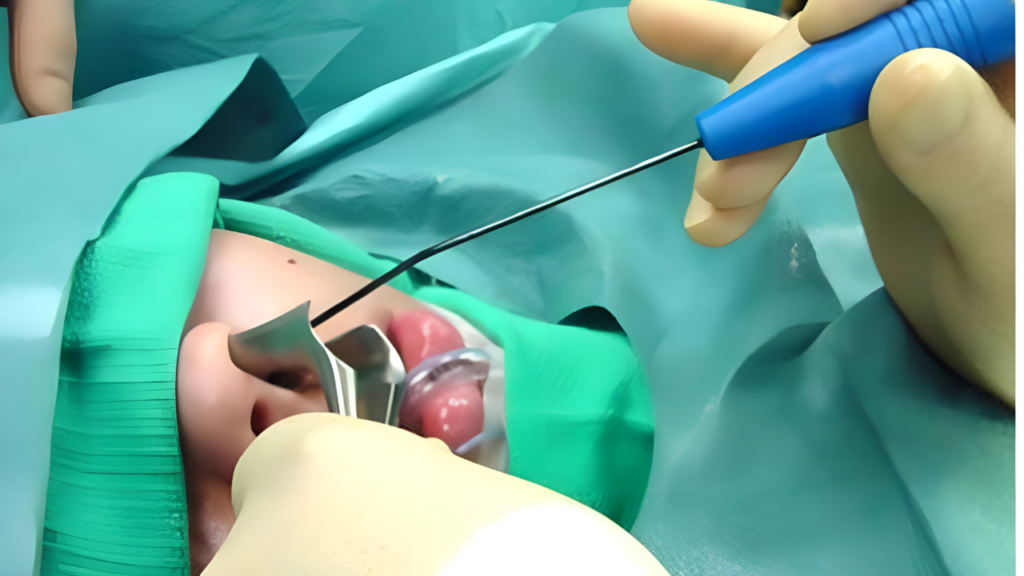Endoscopic Coblation Adenoidectomy in Bhubaneswar Adenoidectomy, the surgical removal of the adenoids, is a frequently performed procedure in otolaryngology designed to relieve chronic nasal blockages, recurring ear infections, or sleep-related breathing issues in children.
Among various surgical techniques, endoscopic coblation-assisted adenoidectomy has gained prominence due to its precision, safety, and effectiveness. Unlike traditional methods, which may involve larger incisions and longer recovery periods, this minimally invasive technique offers numerous advantages, including faster recovery, reduced pain, and minimal bleeding.
Dr. Bulu Nahak, an experienced ENT doctor in Bhubaneswar, is widely recognized for his expertise in performing endoscopic coblation-assisted adenoidectomy and other advanced ENT procedures. This blog discusses the complexity of this groundbreaking surgical technique.
What Are Adenoids?
Adenoids are small clusters of lymphatic tissue situated at the rear of the nasal cavity, close to the roof of the throat. They play a crucial role in the immune system by capturing pathogens that enter through the nose. However, adenoids can become enlarged or chronically infected, leading to conditions such as:
- Nasal obstruction
- Snoring/Obstructive sleep apnea syndrome (OSAS)
- Recurrent sinus infections
- Serous Otitis Media/Glue Ear
When these issues persist despite medical management, surgical intervention becomes necessary. For those seeking professional care, ENT surgery Bhubaneswar offers specialised treatment options for adenoid-related problems.
Step-by-step Procedure Of Adenoidectomy Surgery
Preoperative preparation
- The surgeon evaluates the patient’s symptoms, medical history, and imaging studies (e.g., nasal endoscopy or X-rays) to confirm the need for adenoidectomy. If you’re looking for expert advice and treatment, consult an ENT specialist in Bhubaneswar for comprehensive care.
- General anesthesia is applied to guarantee the patient’s comfort and stillness throughout the procedure.
Endoscopic visualisation
- A small endoscope is inserted through the nose or mouth, providing a magnified, high-definition view of the adenoid tissue.
- The surgeon assesses the size and location of the adenoids and their proximity to surrounding structures, such as the Eustachian tube openings.
Coblation-assisted tissue removal
- A coblation wand is introduced to the surgical site under endoscopic guidance.
- The device uses radiofrequency energy to dissolve the adenoid tissue while simultaneously coagulating blood vessels, minimizing bleeding.
Hemostasis and inspection
- After removing the adenoid tissue, the surgeon ensures thorough hemostasis.
- The endoscope allows for a final inspection to confirm the complete removal of the adenoids and to check for any residual bleeding.
Postoperative care
- In most cases, they can return home the same day, assuming no complications arise. For the best care, it is advisable to visit the best ENT hospital in Bhubaneswar for comprehensive postoperative follow-up and support.
Benefits of Endoscopic Coblation-Assisted Adenoidectomy
Let’s delve into the benefits of Endoscopic coblation-assisted adenoidectomy.
- Enhanced precision: Endoscopic visualization ensures complete removal of adenoid tissue, reducing the risk of recurrence.
- Reduced complications: Coblation technology minimizes bleeding, pain, and thermal damage.
- Faster recovery time: Patients typically experience faster recovery time and can return to their usual routines within 10 to 12 days.
- Improved outcomes: The technique reduces the risk of residual adenoid tissue, leading to better long-term results.
Risks and Complications
Although endoscopic coblation-assisted adenoidectomy is considered safe, potential risks include:
- Bleeding
- Infection
- Changes in voice resonance (rare)
- Residual or regrowth of adenoid tissue
Careful patient selection and surgical expertise can significantly mitigate these risks.
Conclusion
Endoscopic coblation-assisted adenoidectomy represents a significant advancement in the management of adenoid-related disorders. By combining the precision of endoscopic visualization with the minimally invasive nature of coblation technology, this technique ensures safer procedures, quicker recovery, and improved patient outcomes.
For individuals struggling with chronic nasal obstruction or recurrent infections, this innovative surgical approach offers a promising solution. To explore this treatment further and receive expert care, consult Dr. Bulu Nahak, an experienced ENT doctor in Bhubaneswar, who specializes in this advanced procedure.
Frequently Asked Questions
Q1. How is the surgery performed?
Ans. The procedure is performed under general anesthesia. To get a clear view of the adenoids, a slender, bendable endoscope is gently inserted through the nose. The coblation device is then used to remove the adenoid tissue gently and precisely.
Q2. How soon will I see the results after the surgery?
Ans. Improvement is often noticeable within a few days to weeks, as the symptoms caused by enlarged adenoids, such as nasal congestion and sleep disturbances, begin to resolve.
Q3. Why is Endoscopic Coblation-Assisted Adenoidectomy performed?
Ans. This surgery is often performed to treat enlarged adenoids that cause breathing problems, chronic ear infections, nasal congestion, or obstructive sleep apnea in children or adults. For expert evaluation and treatment options, consulting an ENT doctor in Bhubaneswar can help ensure the right approach for your condition.
Q4. What is the recovery time after coblation Adenoidectomy surgery?
Ans. Recovery is typically rapid, with most patients back to normal within 1-2 weeks.
Q5. Who is a candidate for Endoscopic Coblation-Assisted Adenoidectomy?
Ans. Candidates for this procedure include individuals, especially children, who suffer from chronic adenoid-related symptoms such as obstructed breathing, recurrent ear infections, or sleep apnea, and have not responded well to non-surgical treatments.


